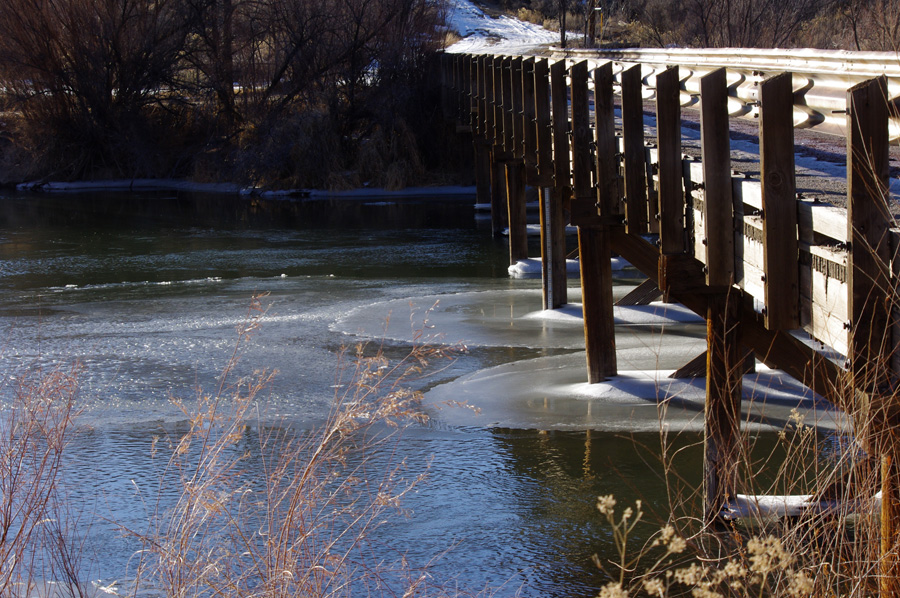After nearly two straight weeks of below-zero lows—minus 17 °F the other night—I thought I needed to post a photo of actual liquid water. This is the Rio Grande at Pilar, NM on Dec. 23, 2012. (Downstream is to the left.) You hardly ever see bridges like this any more, either. The roadbed is built of wooden planks with a little tar and gravel on top. In other words, when you drive across, it goes CLUNK-CLUNK-CLUNK…
Bridge at Pilar

Water is the most reassuring thing in the world in these parts
Sign up for email delivery of JHFARR.COM posts via Substack! Same content sooner with bigger photos! ⬇︎
Previous post: Kachina Peak with Snow
Next post: Above Freezing!

.png)
Just like many bridges in Australia outside the urban areas.
Well, it’s not like I haven’t seen one before, but it has been a while. I wonder why you’d have more of them?
They call it the Grand River, but it’s really a pretty puny thing – not only in its upland beginnings but even where I looked across it once at Laredo. Just some intertwining rivulets in a sandy bed (admittedly a large sandy bed but one with little acquaitance with agua).
Water is a wonderful substance. Let’s raise a glass of something stronger in celebration of it. Here in Canada the most obscure of streams (say, the Rideau River, which I live beside) seems a vast and mighty torrent, especially in the Spring, when the ice breaks up, compared to anything I ever experienced in Texas. Yet here it’s taken for granted. There’s water everywhere. It’s far grander than the Rio Grande but gets no respect. Even our electricity here is called “hydro” because – you guessed it – it comes from water-driven sources. If global warming is all it’s cracked up to be (and you wouldn’t believe it on the evidence of today’s frigid blast) all of Canada may some day be water. We’ll have to rename a certain beverage Canada Wet (we have never been very dry here in any event, least of all during the American prohibition era, when certain fortunes were made in the bootlegging business).
All hail the great god H2O (and certain distilled spirits incorporating the same) wherever he shakes his liquid locks.
Remember the foreshortening effect of the telephoto lens!
The Rio Grande is plenty big this close to the source, but that’s not the point. It’s a RIVER. It’s THE river. The water and its environs have supported unique human cultures for thousands of years. The river has enormous cultural, historical, ecological, and spiritual significance. In Taos County, the Rio Grande anchors some of the most staggering vistas in North America. Its spirit carries the breadth of the impossible landscape. It’s very freaking grande, I assure you.
Amen to all that. There’s an entertaining if somewhat overwritten 2-volume history of the Rio Grande by Paul Horgan called simply “The River”. Nobody would or could write such a book about the mighty but unmythomaniacal Rideau.
My point wasn’t about history, cultural significance or even scenic beauty – simply water. There’s an irony, surely, in a river of such significance being damn near bone dry. Isn’t delivery of the liquid goods the raison d’etre of a river? Other world rivers (the Mississippi, the Amazon, the Nile, even the Thames or the Seine) have volume and majesty as well as history.
This irony is admittedly a rather cheap one: context is everything. The man with one eye is king in the country of the blind. The river with one drop rules the country of the parched.
But Ken, it isn’t by any stretch of the imagination “damn near bone dry” except in TEXAS, where most of it is pumped out on its way to Brownsville. The river up here is very much alive and dangerous.
You must log in to post a comment. Log in now.